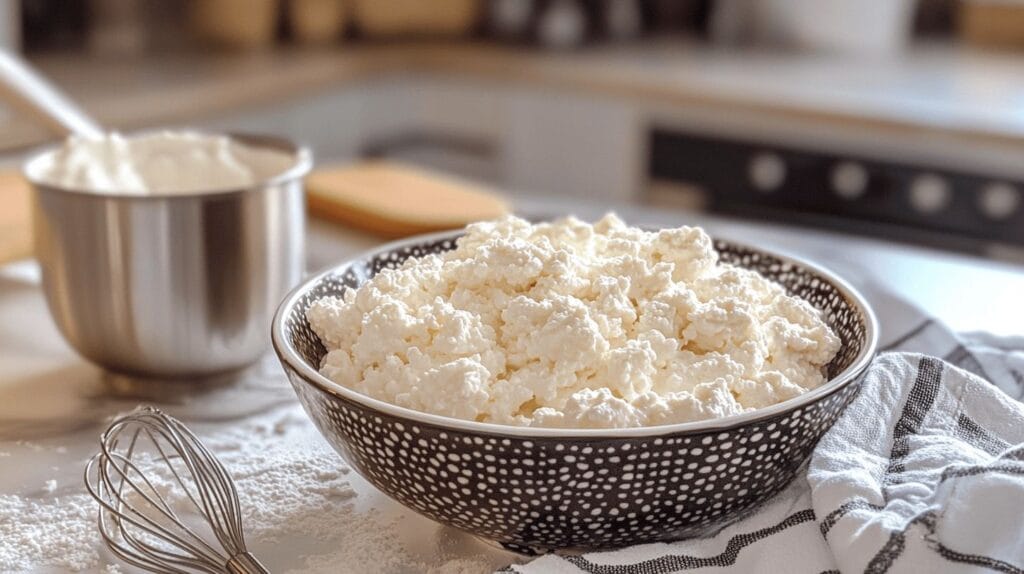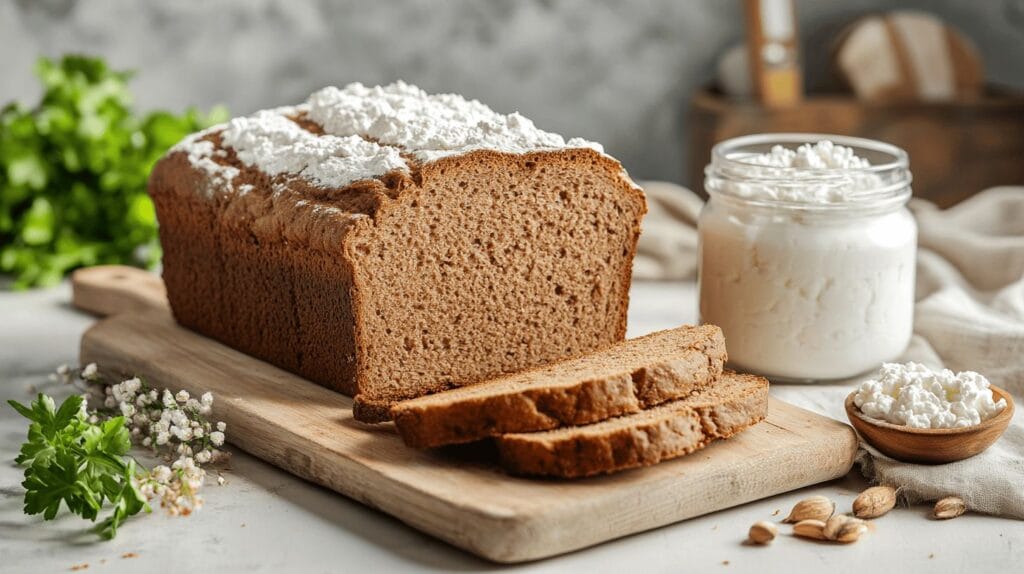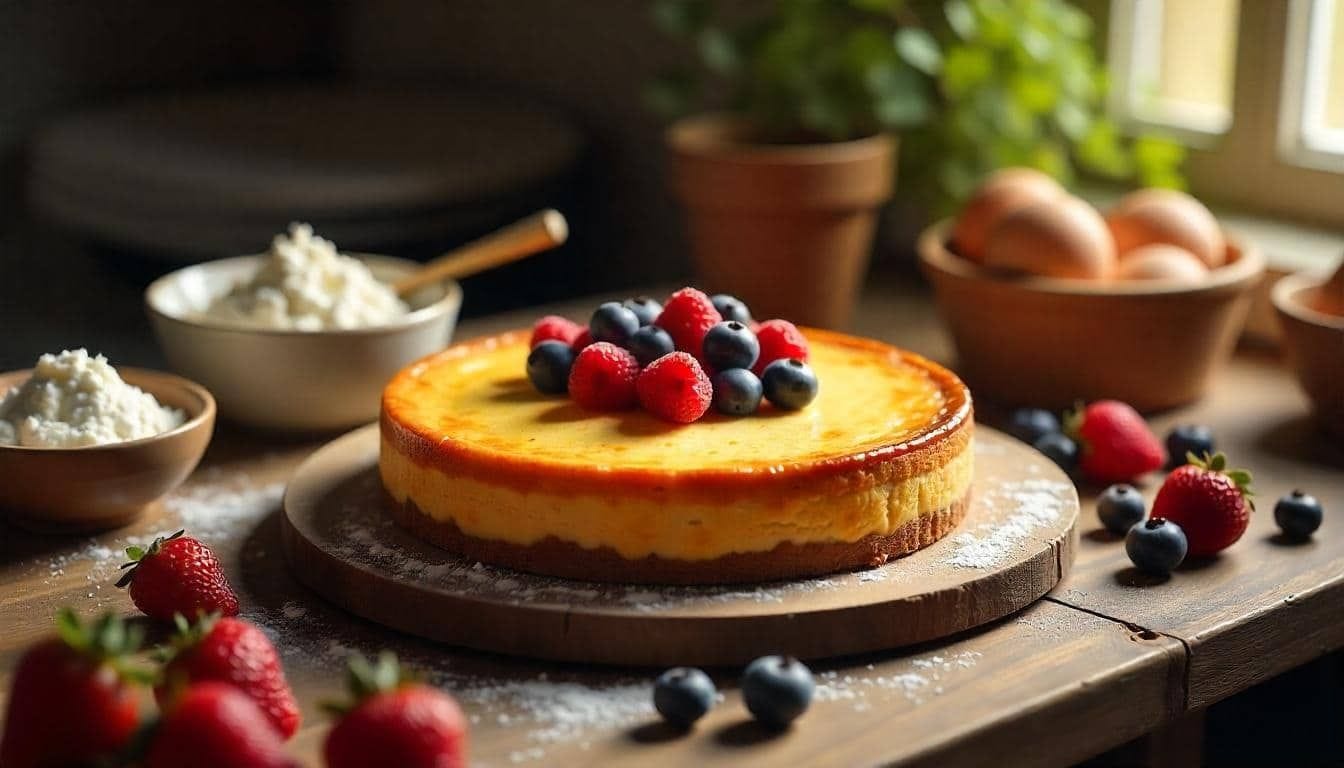Table of Contents
Baking is an art, and experimenting with ingredients can lead to some surprising and delicious results. One question that often pops up is: Can you use cottage cheese for baking? Well, the short answer is yes, and it’s a game-changer. Whether you’re looking for healthier alternatives or want to add a unique twist to your recipes, cottage cheese has you covered. Let’s dive deep into this topic and see how cottage cheese can transform your baking experience.
Introduction to Cottage Cheese in Baking
What is Cottage Cheese?
Cottage cheese is that creamy, lumpy, and mild cheese you’ve likely seen at the grocery store. It’s made from curds of pasteurized cow’s milk, and its slightly tangy flavor makes it versatile for both sweet and savory dishes. Unlike harder cheeses, cottage cheese is soft, moist, and packed with nutrients.Curious about other ways to use this ingredient? Check out Cottage Cheese Recipes You’ll Love for more inspiration.
Why Consider Cottage Cheese for Baking?
Why settle for ordinary when you can make extraordinary baked goods? Cottage cheese isn’t just for salads or snacks. Its creamy texture and mild taste make it an excellent substitute for high-fat ingredients like cream cheese or sour cream. Plus, it’s loaded with protein and calcium, making your treats not only tastier but healthier.
“Using cottage cheese in baking is like adding a secret ingredient that makes everything better – healthier, creamier, and yummier! 🧀✨”
Nutritional Benefits of Using Cottage Cheese
When it comes to baking, choosing ingredients that pack a punch nutritionally is a win-win. Cottage cheese isn’t just about flavor; it’s about boosting the health factor of your baked goods. If you’re looking for more protein-rich meal ideas, you might enjoy Is Cottage Cheese in Scrambled Eggs Good?

High Protein Content for Healthier Recipes
Cottage cheese is a protein powerhouse. With about 13 grams of protein per ½ cup, it helps you feel fuller longer. Imagine munching on a muffin that’s both delicious and keeps you energized throughout the day.
| Nutrient | Quantity (per ½ cup) |
|---|---|
| Calories | 110 |
| Protein | 13 g |
| Fat | 4 g |
| Carbohydrates | 3 g |
| Calcium | 125 mg |
Low-Fat Alternative to Traditional Ingredients
Trying to cut down on fat but still want rich, creamy desserts? Cottage cheese is your new best friend. It provides the same creamy texture as heavy cream or butter but with far fewer calories and fat.
Unique Texture and Moisture Retention
Ever baked a cake that turned out dry? Cottage cheese has a high moisture content that keeps baked goods tender and moist. Say goodbye to dry and crumbly cakes forever!
Common Baking Recipes with Cottage Cheese
You’re probably wondering, what can I bake with cottage cheese? The answer is… almost anything! Here are some popular recipes where cottage cheese shines.
Cottage Cheese in Cheesecakes
Love cheesecake but hate the calorie count? Swap out cream cheese for cottage cheese, and you’ll still get that creamy, dreamy texture with fewer calories. Just blend the cottage cheese until smooth before using it in your recipe.
“Think of cottage cheese as the underdog of baking ingredients. It doesn’t get the spotlight, but it works magic behind the scenes. ✨🍰”
Adding Cottage Cheese to Muffins and Cupcakes
Cottage cheese adds a surprising twist to muffins and cupcakes. It creates a light, fluffy texture and pairs wonderfully with fruits like blueberries or bananas. Pro tip: Mash the cottage cheese into smaller bits for smoother batter.
Using Cottage Cheese for Bread and Doughs
Yes, you can use cottage cheese in bread! Its creamy consistency keeps the dough soft, and its tangy flavor adds depth. Whether it’s savory garlic bread or sweet cinnamon rolls, cottage cheese can handle it.
Sweet and Savory Cottage Cheese Pies
From quiches to fruit pies, cottage cheese is the secret ingredient you didn’t know you needed. It blends beautifully with eggs and sugar for custard-like fillings or with herbs and veggies for savory pies.
Tips for Successfully Baking with Cottage Cheese
Now that you’re ready to bake, let’s ensure your creations come out perfectly. Cottage cheese has a few quirks, but with these tips, you’ll nail it every time.
Choosing the Right Type of Cottage Cheese
Not all cottage cheese is created equal. For baking, go for small curd cottage cheese if you prefer a smoother texture. If you want a chunkier texture in savory dishes, large curd works great.
How to Properly Prepare Cottage Cheese for Recipes
To avoid a watery mess, drain your cottage cheese before using it. Simply place it in a fine-mesh strainer or wrap it in a clean kitchen towel and squeeze out the excess liquid.
Balancing Flavors: Sweet vs. Savory Dishes
Cottage cheese has a slightly tangy flavor that can lean sweet or savory depending on what you add. Pair it with vanilla and sugar for desserts or herbs and spices for savory treats.
Common Problems When Baking with Cottage Cheese and Solutions
While baking with cottage cheese can yield incredible results, it’s not without its challenges. Luckily, most issues are easy to fix with a few handy tricks. Let’s tackle some common problems so you can bake with confidence.
Issue: Watery Texture in Batters
Cottage cheese is naturally high in moisture, which can sometimes make batters too runny or prevent baked goods from setting properly. Nobody wants a soggy cake, right?
Solution: Straining Cottage Cheese Effectively
The key is to strain the cottage cheese before using it. Here’s how:
- Place the cottage cheese in a fine-mesh sieve or cheesecloth.
- Allow it to sit over a bowl for 15–20 minutes to let the excess liquid drip out.
- For quicker results, gently press the cheese with a spoon or twist the cheesecloth to remove moisture.
“A little straining goes a long way. Think of it as prepping your cottage cheese to be the star of the baking show!”
Issue: Overpowering Flavor in Recipes
Some people find the tangy flavor of cottage cheese a bit too strong, especially in sweet dishes. Don’t worry—this is an easy fix.
Solution: Combining with Complementary Ingredients
To balance the flavor:
- For sweet dishes, mix cottage cheese with ingredients like vanilla extract, honey, or cinnamon to mask its tanginess.
- For savory recipes, pair it with herbs like basil or parsley, or even a pinch of garlic powder.
This trick ensures that the cottage cheese blends seamlessly into your dish, enhancing rather than overpowering it.
Substitutions and Alternatives for Cottage Cheese
What if you run out of cottage cheese or want to try a slightly different taste? There are plenty of alternatives you can use without compromising the recipe.
Want to explore how other dairy products can transform your baking? Take a look at Why Use Buttermilk Instead of Milk in Baking for tips on another versatile ingredient.
Replacing Cottage Cheese with Ricotta
Ricotta cheese is the closest substitute for cottage cheese. It has a similar creamy texture but is slightly milder in taste, making it an excellent swap for both sweet and savory recipes.
| Ingredient | Substitution Ratio |
|---|---|
| Cottage Cheese | 1:1 with Ricotta |
Using Greek Yogurt or Cream Cheese Instead
For a creamier consistency:
- Greek yogurt works wonders in cakes and muffins. It’s tangier than cottage cheese but adds a lovely creaminess.
- Cream cheese is ideal for cheesecakes and frostings, though it’s heavier and richer than cottage cheese.
Expert Tips for Making Cottage Cheese-Based Desserts
Ready to impress your friends and family with some delightful desserts? These tips will take your cottage cheese baking game to the next level.
Achieving the Perfect Cheesecake Consistency
Blending is your best friend when making cheesecakes with cottage cheese. Use a blender or food processor to puree it until smooth. This removes the lumps and ensures a silky texture in your cheesecake.
“When in doubt, blend it out! Smooth cottage cheese means smooth, creamy desserts.”
Enhancing Flavors with Spices and Extracts
A dash of creativity can elevate your baked goods. Try these ideas:
- Add vanilla extract for a classic touch.
- Sprinkle in nutmeg or cinnamon for warmth.
- Use lemon zest for a refreshing zing in cheesecakes or muffins.
The Versatility of Cottage Cheese in Gluten-Free Baking
For those following a gluten-free diet, cottage cheese is a fantastic addition to your baking arsenal. Its creaminess and binding properties make it a natural fit for gluten-free recipes.
For more gluten-free baking insights, check out What Ingredient Keeps Cornbread from Crumbling.

Benefits of Cottage Cheese in Gluten-Free Recipes
Gluten-free flours, like almond or rice flour, can sometimes make baked goods dry and crumbly. Cottage cheese solves this problem by:
- Adding moisture and creaminess.
- Providing structure to gluten-free cakes and breads.
Recipe Ideas for Gluten-Free Bakers
Here are a couple of gluten-free recipes to try:
- Cottage Cheese Pancakes
Mix cottage cheese with eggs, almond flour, and a touch of vanilla for fluffy, protein-packed pancakes. - Gluten-Free Cottage Cheese Brownies
Blend cottage cheese into your brownie batter for extra richness and a fudgy texture.
“Gluten-free baking doesn’t have to be boring. With cottage cheese, you can create treats that are both delicious and nutritious. 🍪💪”
This wraps up the second part of the article. Let me know if you’d like me to proceed with the final section, which will cover frequently asked questions, additional recipes, and a conclusion to tie it all together!
Frequently Asked Questions about Cottage Cheese in Baking
Is cottage cheese good for baking?
Yes, cottage cheese is an excellent ingredient for baking! It adds a creamy texture, keeps baked goods moist, and boosts the protein content of your recipes. Plus, it’s a versatile alternative to high-fat ingredients like sour cream or heavy cream. Whether you’re making cheesecakes, muffins, or breads, cottage cheese can enhance both flavor and nutrition.
Does cottage cheese melt when you bake it?
Cottage cheese doesn’t melt in the same way that mozzarella or cheddar does. Instead, it softens and blends into the batter, giving a creamy texture to your baked goods. If you prefer a completely smooth consistency, you can blend the cottage cheese before adding it to your recipe.
“Think of cottage cheese as a hidden helper—it won’t melt like gooey cheese, but it will work magic to make your bakes tender and delicious!”
Can you use cottage cheese instead of cream cheese in baking?
Absolutely! Cottage cheese can be a great substitute for cream cheese, especially if you’re looking for a lighter alternative. To replace cream cheese, blend cottage cheese until smooth to mimic the creamy consistency. This works particularly well in cheesecakes, frostings, and dips, though the flavor will be slightly tangier.
Can I use cottage cheese instead of milk in baking?
Yes, you can substitute cottage cheese for milk in baking. Simply blend the cottage cheese with a small amount of water or milk to achieve a smoother, milk-like consistency. This substitution works well in recipes like pancakes, muffins, and cakes, adding both creaminess and protein.
“When you’re out of milk, cottage cheese can step in to save the day. Just blend, bake, and enjoy the results!”
Conclusion: Why You Should Try Baking with Cottage Cheese
By now, you’ve learned that cottage cheese isn’t just a humble snack—it’s a versatile, nutritious, and delicious ingredient that can elevate your baking. Whether you’re whipping up a creamy cheesecake, moist muffins, or even gluten-free brownies, cottage cheese has something to offer.
Recap of Benefits and Versatility
Here’s why cottage cheese deserves a spot in your pantry:
- It’s packed with protein and calcium, making your treats healthier.
- Its creamy texture keeps baked goods moist and tender.
- It works in both sweet and savory recipes, giving you endless possibilities.
Feeling inspired? Visit Cottage Cheese Recipes You’ll Love to start experimenting with this incredible ingredient today!
Encouragement to Experiment with Recipes
Don’t be afraid to experiment. Baking is all about having fun and finding what works for you. Swap out traditional ingredients for cottage cheese and see the magic unfold. Who knows—you might just discover your new favorite recipe!
“Baking is like a science experiment, and cottage cheese is your secret ingredient for success. So, roll up your sleeves and get baking! 🎂🎉”
Bonus Recipe: Cottage Cheese Banana Bread
Let’s end with a simple and delicious recipe to get you started:
Ingredients
| Ingredient | Quantity |
|---|---|
| Ripe bananas | 3 |
| Cottage cheese | 1 cup (blended) |
| Eggs | 2 |
| All-purpose flour | 2 cups |
| Baking powder | 1 tsp |
| Baking soda | ½ tsp |
| Sugar | ¾ cup |
| Vanilla extract | 1 tsp |
| Cinnamon | ½ tsp |
Instructions
- Preheat your oven to 350°F (175°C). Grease a loaf pan.
- Mash the bananas in a large bowl.
- Blend the cottage cheese until smooth and mix it with the bananas.
- Add the eggs, sugar, and vanilla extract. Mix well.
- In a separate bowl, combine the flour, baking powder, baking soda, and cinnamon.
- Gradually add the dry ingredients to the wet mixture and stir until combined.
- Pour the batter into the loaf pan and bake for 50–60 minutes, or until a toothpick comes out clean.
- Let it cool, slice, and enjoy!
“This banana bread is proof that cottage cheese belongs in your kitchen. Give it a try—you won’t regret it! 🍌🍞”
There you have it—the full guide to baking with cottage cheese. Now it’s your turn to grab some cottage cheese and start creating delicious masterpieces. Happy baking! 🧁✨

